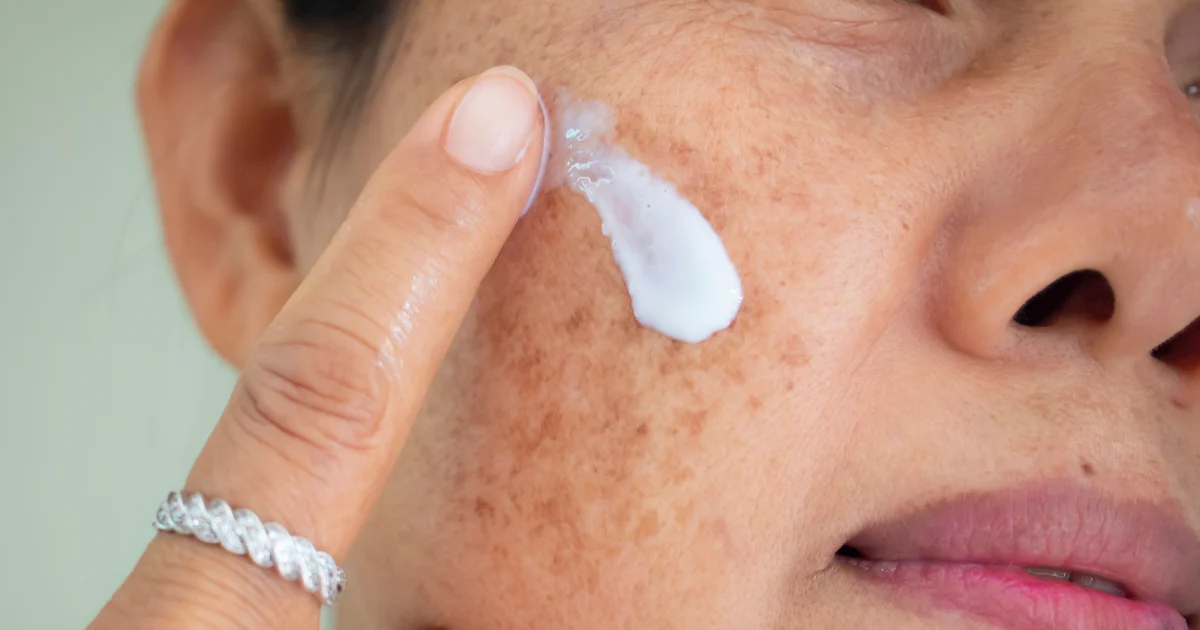Dark spots, also known as hyperpigmentation, are a common concern for many individuals. These are areas of the skin that appear darker than the surrounding skin tone, resulting from an overproduction of melanin, the pigment responsible for skin color. Dark spots can be caused by various factors such as sun exposure, hormonal changes, acne scars, and aging.
In recent years, there has been a growing interest in natural remedies for various skin issues, including dark spots. People are seeking alternatives to chemical-laden products and turning to household items for potential solutions. Among the plethora of home remedies, toothpaste has emerged as a popular suggestion for fading dark spots overnight.
The idea behind using toothpaste as a dark spot treatment is intriguing. Toothpaste contains ingredients known for their cleansing and whitening properties, such as baking soda, hydrogen peroxide, and menthol. Proponents of this remedy claim that these ingredients can effectively lighten dark spots when applied directly to the affected areas.
However, before jumping on the toothpaste bandwagon, it is crucial to assess the validity of this claim and explore the potential benefits, risks, and scientific evidence supporting or refuting this home remedy. This blog post aims to delve into the toothpaste and dark spots connection, offering an in-depth analysis to help you make informed decisions about your skincare routine.
Recommended: Does Colgate Remove Dark Spots On Legs?
By examining the scientific perspective, debunking common myths, and exploring alternative treatments, we aim to provide clarity on whether toothpaste can genuinely fade dark spots overnight or if there are more reliable and evidence-based options available. It is essential to remember that skincare decisions should be based on reliable information and consultation with skin care professionals to ensure the best outcomes for your skin health.
Understanding Dark Spots
Definition and causes of dark spots
Dark spots, also known as hyperpigmentation, are localized areas of the skin that appear darker than the surrounding skin tone. This discoloration occurs due to an increase in melanin production in specific areas of the skin. Melanin is the pigment responsible for determining the color of our hair, eyes, and skin.
There are different types of dark spots, including age spots (lentigines), melasma, post-inflammatory hyperpigmentation (PIH), and sunspots (solar lentigines). Age spots are commonly associated with aging and prolonged sun exposure, while melasma is often related to hormonal changes, such as during pregnancy or while taking birth control pills. PIH occurs as a result of inflammation or injury to the skin, such as acne breakouts or skin trauma, and sunspots are caused by cumulative sun exposure over time.

Differentiating between hyperpigmentation and other skin issues
It is important to distinguish hyperpigmentation from other skin concerns to ensure appropriate treatment. Conditions like freckles, birthmarks, and moles have different underlying causes and require different approaches.
Recommended: Does Colgate Remove Dark Spots?
Freckles are small, flat spots that are genetically determined and tend to darken with sun exposure. Birthmarks, on the other hand, are present from birth and can vary in size, shape, and color. Moles are typically harmless and can be flat or raised, but a dermatologist should examine any changes in size, shape, or color to rule out any potential concerns.
Common areas affected by dark spots
Dark spots can appear on various body areas, but they are most commonly found on the face, hands, arms, shoulders, and back. These areas are often more exposed to sunlight, making them more susceptible to sun-induced hyperpigmentation.
Understanding dark spots’ causes and characteristics is essential for effective treatment strategies. While toothpaste may seem like a convenient solution, it is crucial to explore its efficacy and potential risks before incorporating it into your skincare routine.
Recommended: Does Colgate Remove Dark Spots On Face?
In the following sections, we will delve deeper into the toothpaste remedy, scientific perspectives, alternative treatments, and debunking common myths surrounding its effectiveness in fading dark spots overnight.
Exploring Toothpaste as a Remedy
Origins of the toothpaste remedy myth
The notion of using toothpaste as a remedy for dark spots has circulated for quite some time. It likely originated from anecdotal experiences or old wives’ tales suggesting that the ingredients found in toothpaste can help lighten skin discolorations. The accessibility and affordability of toothpaste also contribute to its popularity as a home remedy.
Recommended: Toothpaste For Dark Underarms: Is It Effective?
Ingredients in toothpaste and their potential effects
Toothpaste typically contains several ingredients that are believed to have skin-related benefits. For instance, baking soda is known for its exfoliating properties, which can help remove dead skin cells and potentially lighten dark spots.
Hydrogen peroxide, commonly found in whitening toothpaste, is a bleaching agent that some claim can lighten hyperpigmentation. Menthol, another ingredient in toothpaste, has a cooling effect that may provide temporary relief from inflammation.
Role of Fluoride and its Impact on dark spots
Fluoride is a key ingredient in most toothpaste formulations, as it helps prevent tooth decay and strengthen enamel. While fluoride has oral health benefits, there is limited evidence to suggest its effectiveness in treating dark spots on the skin.
Fluoride’s primary mode of action is different from the mechanisms involved in skin pigmentation regulation, making its impact on dark spots uncertain.
Antimicrobial properties of certain toothpaste ingredients
Some toothpaste ingredients, such as triclosan or essential oils like tea tree oil or eucalyptus oil, possess antimicrobial properties. These antimicrobial agents are included in toothpaste to combat bacteria and plaque in the oral cavity. However, it is important to note that the antimicrobial properties of these ingredients do not necessarily translate to effective treatment for hyperpigmentation or dark spots.
Recommended: Colgate For Dark Knees: Does It Work?
While toothpaste may contain ingredients with potential skin-related benefits, it is crucial to approach its use as a remedy for dark spots with caution. The efficacy of toothpaste in fading dark spots overnight lacks scientific evidence and research.
In the next section, we will delve into the scientific perspective to gain a better understanding of the potential risks and limitations associated with using toothpaste on the skin.
Scientific Perspective
Lack of scientific evidence supporting toothpaste as a dark spot treatment
Despite the widespread belief in toothpaste’s ability to fade dark spots, it is important to highlight the lack of scientific research and evidence supporting this claim. There have been no specific studies conducted to investigate the effectiveness of toothpaste in treating hyperpigmentation or dark spots on the skin.
The available scientific literature primarily focuses on toothpaste’s oral health benefits rather than its dermatological applications.
Potential risks and side effects of using toothpaste on the skin
Using toothpaste as a remedy for dark spots may carry certain risks and side effects. Toothpaste formulations are primarily designed for oral use, and their ingredients may not be suitable for application on the skin.
Some toothpaste ingredients, such as sodium lauryl sulfate (SLS) or menthol, can cause skin irritation, redness, or allergic reactions in sensitive individuals.
Additionally, the abrasive nature of toothpaste, particularly those containing baking soda or silica, can lead to skin damage or increased sensitivity.
Recommended: How To Remove Dark Inner Thighs With Colgate
Importance of consulting a dermatologist for professional advice
When dealing with skin concerns, it is always advisable to consult a dermatologist or skincare professional. They possess the expertise and knowledge to accurately diagnose and recommend appropriate treatments for various skin conditions, including dark spots.
Dermatologists can provide personalized advice based on an individual’s skin type, medical history, and specific concerns, ensuring a safe and effective approach to addressing hyperpigmentation.
Relying on evidence-based treatments and professional guidance is crucial for achieving desired outcomes while minimizing potential risks. Although toothpaste may seem like a convenient and inexpensive option, it is essential to consider alternative treatments that are backed by scientific research and have a proven track record in treating dark spots effectively.
In the next section, we will explore alternative treatments for dark spots, providing a range of options to consider in your skincare routine.
Alternative Treatments for Dark Spots
Dermatological options (e.g., topical creams, laser treatments)
Dermatologists offer various treatments for dark spots that have been extensively studied and proven effective. Topical creams containing ingredients like hydroquinone, retinoids, azelaic acid, or kojic acid can help lighten hyperpigmentation when used under medical supervision. These ingredients work by inhibiting melanin production or promoting skin cell turnover.
In addition, dermatologists may recommend advanced treatments such as chemical peels, microdermabrasion, or laser therapies. Chemical peels involve the application of a chemical solution to exfoliate the skin, while microdermabrasion uses a device to gently remove the top layer of skin.
Recommended: Dark Inner Thighs? 8 Effective Home Remedies
Laser treatments, including intense pulsed light (IPL) or fractional lasers, can target dark spots and stimulate collagen production for a more even complexion.
Natural remedies backed by research (e.g., vitamin C, aloe vera)
Natural remedies can also be considered for addressing dark spots, particularly those supported by scientific research. Vitamin C, for instance, is an antioxidant that can inhibit melanin production and brighten the skin. Applying products containing vitamin C or consuming foods rich in this nutrient may help reduce the appearance of dark spots over time.

Aloe vera, known for its soothing and healing properties, has also shown promise in improving hyperpigmentation. Studies have suggested that aloe vera gel can inhibit tyrosinase, an enzyme involved in melanin synthesis, leading to a reduction in dark spots. Applying pure aloe vera gel or products containing aloe vera extract may contribute to a more even skin tone.
Skincare routine and preventive measures
Establishing a comprehensive skincare routine can aid in the prevention and management of dark spots. Regularly cleansing the skin, using sunscreen with broad-spectrum protection, and avoiding excessive sun exposure are essential steps in preventing further hyperpigmentation. Sunscreen should be applied generously and reapplied every two hours, especially when spending prolonged periods outdoors.
Recommended: Dark Armpit: Causes And 10 Natural Ways To Get Rid Of It
Incorporating products with ingredients like niacinamide, licorice extract, or alpha hydroxy acids (AHAs) in your skincare routine may also help fade dark spots gradually. These ingredients have skin-brightening and exfoliating properties that can promote a more even skin tone over time.
It is important to note that the effectiveness of alternative treatments can vary depending on individual factors, such as skin type, severity of hyperpigmentation, and consistency of use. Consulting with a dermatologist or skincare professional is recommended to determine the most suitable treatment options for your specific needs.
By exploring these alternative treatments, individuals can make informed decisions about their skincare routine and choose approaches that are supported by scientific evidence and tailored to their unique circumstances.
In the next section, we will address common myths surrounding toothpaste as a dark spot treatment and emphasize the importance of relying on evidence-based solutions.
Debunking Common Myths
Myth: Toothpaste is a quick and effective overnight solution for fading dark spots
Reality: Despite popular belief, there is no scientific evidence to support the claim that toothpaste can effectively fade dark spots overnight. Dark spots require consistent and targeted treatment over a period of time to see noticeable improvements. Relying solely on toothpaste as a quick fix can lead to disappointment and potential skin irritation.
Myth: All toothpaste formulations are suitable for treating dark spots
Reality: Toothpaste formulations vary widely, and not all are suitable for application on the skin. Some toothpaste ingredients, such as sodium lauryl sulfate (SLS), menthol, or abrasive agents like baking soda or silica, can cause skin irritation, redness, or allergies. It is important to use skincare products specifically formulated for the skin and to consult a dermatologist for personalized advice.
Recommended: Does Vaseline Fade Scars? How To Remove Scars Fast
Myth: Fluoride in toothpaste can effectively lighten dark spots
Reality: While fluoride is beneficial for oral health and strengthening tooth enamel, its impact on dark spots or hyperpigmentation is uncertain. The mechanisms involved in regulating skin pigmentation differ from those involved in tooth health. Therefore, relying on fluoride in toothpaste as a treatment for dark spots may not yield the desired results.
Myth: Toothpaste can provide long-lasting and permanent results in fading dark spots
Reality: Dark spots are often deeply rooted in the skin and require consistent and targeted treatment to fade over time. While toothpaste may temporarily lighten the appearance of dark spots due to its drying or exfoliating effects, these results are usually temporary. Long-lasting and permanent results in treating hyperpigmentation typically require dermatological treatments or targeted skincare products.
Myth: Toothpaste is a cost-effective alternative to professional treatments
Reality: While toothpaste may appear cost-effective initially, its effectiveness in treating dark spots is questionable. Investing in evidence-based treatments recommended by dermatologists may yield better and more predictable results in the long run. Professional treatments are tailored to individual needs and offer the advantage of medical expertise and monitoring for optimal outcomes.
Recommended: Why Do I Have Acne And My Siblings Don’t?
It is essential to base skincare decisions on scientific evidence, professional advice, and reliable sources of information. By debunking these common myths surrounding toothpaste as a dark spot treatment, individuals can make informed choices and opt for more effective and proven methods to address hyperpigmentation.
Conclusion
Dark spots, or hyperpigmentation, cannot be effectively faded overnight with toothpaste, despite popular belief. Toothpaste lacks scientific evidence and may cause skin irritation. Dermatological options and natural remedies supported by research offer better alternatives. Consulting a dermatologist is crucial for personalized advice and tailored treatments. Debunking common myths highlights the importance of evidence-based approaches for treating dark spots.
Establishing a comprehensive skincare routine, including sun protection and using products with proven ingredients like vitamin C, can gradually improve hyperpigmentation. Embracing an evidence-based approach and seeking professional guidance will lead to more effective and safer results in achieving a clearer and more radiant complexion.
